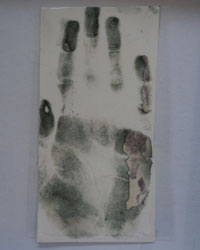10 Sep 2014
New weapon will help fight against metal theft from historic buildings
 A handprint showing an area that had been in contact with bronze
A handprint showing an area that had been in contact with bronze
Light-fingered thieves who steal from Britain’s oldest and most treasured buildings are to be caught red-handed - and brown and black - thanks to a forensic detection system developed by Loughborough scientists.
The technique was devised by Dr Paul Kelly and his research group and is cheap, simple and, unlike some methods, non-invasive for the suspect and the results can be stored and used many days later.
Dr Kelly is hopeful that the police and the heritage sector will take advantage of a procedure which could help the fight against a crime, particularly in the form of metal theft, that is having a huge impact on Britain’s history and its economy.
The procedure involves two basic components - a gelatine sheet (the sort normally used to lift developed fingerprints or footprints), and the developing reagent rubeanic acid.
The gelatine sheet is placed on the hands of anyone suspected of metal theft.
Because residual traces of metal are left on the skin after metal has been handled, those are transferred to the gelatine sheet.
When sprayed with the rubeanic acid, the result is a ‘map’ of whatever was held, even showing patterns or breaks in the metal.
Each metal produces a different colour. Copper comes up as black, lead as brown, after further treatment with UV, and nickel as violet, after being treated with ammonia.
The gelatine sheets and rubeanic acid are cheap and, because the acid is sprayed on to the gelatine sheets, and not a suspect’s hands, the technique is non-invasive.
To read press release click here














